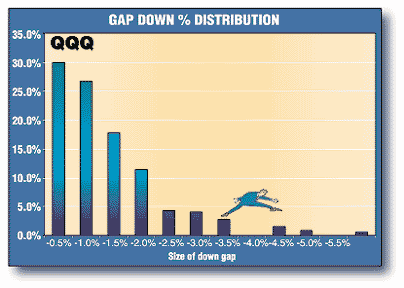TRADING TECHNIQUES
Mind The Gap
Daytrading QQQ
by Misha T. Sarkovich, Ph.D.
Looking at price history can help you become a more successful trader.
The QQQ is an exchange-traded fund (Etf), sometimes referred to as "cubes" or "Qs." The QQQ is traded primarily on the exchange floor of the American Stock Exchange (Amex) and represents a price index of Nasdaq 100's largest stocks. In essence, the QQQ allows investors and traders to buy or sell shares in the collective stock performance of an entire stock portfolio as a single security. Other common exchange-traded funds are SPY and DIA, which are also referred to as "spiders" and "diamonds." These represent the price indexes of the Standard & Poor's 500 index and the Dow Jones industrials, respectively.
THE BASICS
QQQs, SPYs, and DIAs are ETFs that are unit investment trusts governed by the Investment Company Act of 1940, while iShares and Select Sector Spdrs are structured as open-end mutual funds or managed investment companies. ETFs must replicate the holdings of the underlying index. Subsequently, the ETFs are continuously created and redeemed by large financial institutions (that is, the authorized participants) in large block units of 50,000 shares to reflect the actual buying and selling of ETF shares. In addition, ETFs are held only in the book entry format, without any traditional stock certificates. Shares of ETFs can be bought and sold on the secondary market (that is, the Amex) easily and without any concern for the complex underlying mechanisms of ETF creation, redemption, dividend distribution, or clearing.

FIGURE 1: QQQ GAP DOWN PRICE DISTRIBUTION. About 30% of gaps down are less than 0.5% change in price, and 27% are between 0.5 and 1%.
...Continued in the March 2003 issue of Technical Analysis of STOCKS & COMMODITIES.
Excerpted from an article originally published in the March 2003 issue of Technical Analysis of STOCKS & COMMODITIES magazine. All rights reserved. © Copyright 2003, Technical Analysis, Inc.